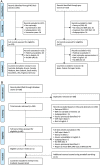Rising prevalence of BMI ≥40 kg/m2 : A high-demand epidemic needing better documentation
- PMID: 32017386
- PMCID: PMC7078951
- DOI: 10.1111/obr.12986
Rising prevalence of BMI ≥40 kg/m2 : A high-demand epidemic needing better documentation
Abstract
Whilst previously rare, some surveys indicate substantial increases in the population with body mass index (BMI) ≥40 kg/m2 since the 1980s. Clinicians report emerging care challenges for this population, often with high resource demands. Accurate prevalence data, gathered using reliable methods, are needed to inform health care practice, planning, and research. We searched digitally for English language sources with measured prevalence data on adult BMI ≥40 collected since 2010. The search strategy included sources identified from recent work by NCD-RisC (2017), grey sources, a literature search to find current sources, and digital snowball searching. Eighteen countries, across five continents, reported BMI ≥40 prevalence data in surveys since 2010: 12% of eligible national surveys examined. Prevalence of BMI ≥40 ranged from 1.3% (Spain) to 7.7% (USA) for all adults, 0.7% (Serbia) to 5.6% (USA) for men, and 1.8% (Poland) to 9.7% (USA) for women. Limited trend data covering recent decades support significant growth of BMI ≥40 population. Methodological limitations include small samples and data collection methods likely to exclude people with very high BMIs. BMI ≥40 data are not routinely reported in international surveys. Lack of data impairs surveillance of population trends, understanding of causation, and societal provision for individuals living with higher weights.
Keywords: BMI ≥40; data quality; prevalence; severe obesity.
© 2020 The Authors. Obesity Reviews published by John Wiley & Sons Ltd on behalf of World Obesity Federation.
Conflict of interest statement
The authors declare no competing financial interests in relation to this work.
Figures



Similar articles
-
Trends in adult body-mass index in 200 countries from 1975 to 2014: a pooled analysis of 1698 population-based measurement studies with 19·2 million participants.Lancet. 2016 Apr 2;387(10026):1377-1396. doi: 10.1016/S0140-6736(16)30054-X. Lancet. 2016. PMID: 27115820 Free PMC article. Review.
-
Folic acid supplementation and malaria susceptibility and severity among people taking antifolate antimalarial drugs in endemic areas.Cochrane Database Syst Rev. 2022 Feb 1;2(2022):CD014217. doi: 10.1002/14651858.CD014217. Cochrane Database Syst Rev. 2022. PMID: 36321557 Free PMC article.
-
Body-mass index and obesity in urban and rural China: findings from consecutive nationally representative surveys during 2004-18.Lancet. 2021 Jul 3;398(10294):53-63. doi: 10.1016/S0140-6736(21)00798-4. Lancet. 2021. PMID: 34217401 Free PMC article.
-
Worldwide trends in body-mass index, underweight, overweight, and obesity from 1975 to 2016: a pooled analysis of 2416 population-based measurement studies in 128·9 million children, adolescents, and adults.Lancet. 2017 Dec 16;390(10113):2627-2642. doi: 10.1016/S0140-6736(17)32129-3. Epub 2017 Oct 10. Lancet. 2017. PMID: 29029897 Free PMC article.
-
Body-mass index and diabetes risk in 57 low-income and middle-income countries: a cross-sectional study of nationally representative, individual-level data in 685 616 adults.Lancet. 2021 Jul 17;398(10296):238-248. doi: 10.1016/S0140-6736(21)00844-8. Lancet. 2021. PMID: 34274065 Free PMC article.
Cited by
-
Challenges in obtaining accurate anthropometric measures for adults with severe obesity: A community-based study.Scand J Public Health. 2023 Aug;51(6):935-943. doi: 10.1177/14034948221089111. Epub 2022 May 1. Scand J Public Health. 2023. PMID: 35491931 Free PMC article.
-
Association between intraoperative plantar regional oxygen saturation and acute kidney injury after cardiac surgery.J Clin Monit Comput. 2023 Apr;37(2):525-540. doi: 10.1007/s10877-022-00917-y. Epub 2022 Nov 2. J Clin Monit Comput. 2023. PMID: 36319881
-
Short- and long-term risk of atrial fibrillation recurrence after first time ablation according to body mass index: a nationwide Danish cohort study.Europace. 2023 Feb 16;25(2):425-432. doi: 10.1093/europace/euac225. Europace. 2023. PMID: 36480430 Free PMC article.
-
Nonnormative Eating Behaviors and Eating Disorders and Their Associations With Weight Loss and Quality of Life During 6 Years Following Obesity Surgery.JAMA Netw Open. 2022 Aug 1;5(8):e2226244. doi: 10.1001/jamanetworkopen.2022.26244. JAMA Netw Open. 2022. PMID: 35951326 Free PMC article.
-
Depression was associated with younger age, female sex, obesity, smoking, and physical inactivity, in 1027 patients with newly diagnosed type 2 diabetes: a Swedish multicentre cross-sectional study.BMC Endocr Disord. 2022 Nov 9;22(1):273. doi: 10.1186/s12902-022-01184-3. BMC Endocr Disord. 2022. PMID: 36348470 Free PMC article.
References
-
- Finkelstein EA, Khavjou OA, Thompson H, et al. Obesity and severe obesity forecasts through 2030. Am J Prev Med. 2012;42(6):563‐570. - PubMed
-
- Lumley E, Homer CV, Palfreyman S, Shackley P, Tod AM. A qualitative study to explore the attitude of clinical staff to the challenges of caring for obese patients. J Clin Nurs. 2015;Dec;24(23‐24):3594‐3604. - PubMed
Publication types
MeSH terms
Grants and funding
LinkOut - more resources
Full Text Sources

